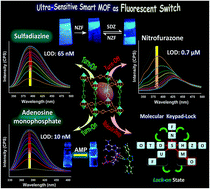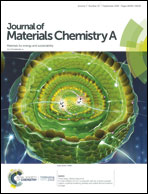Antibiotic-triggered reversible luminescence switching in amine-grafted mixed-linker MOF: exceptional turn-on and ultrafast nanomolar detection of sulfadiazine and adenosine monophosphate with molecular keypad lock functionality†
Abstract
Monitoring toxic and biorelevant organo-aromatics necessitates fast-responsive, highly discriminative, and ultralow detection with regenerative attributes, where an analyte-triggered multiresponsive system can prove to be a practical tool for futuristic sensing capabilities. The strategically functionalized mixed-linker luminescent metal–organic framework (LMOF) [Zn2(azdc)2(dpta])·(DMF)4 (CSMCRI-2), built via a combination of azo-functionalized H2azdc ligand and –NH2-moiety-appended dpta linker, functions as an exclusive probe for the detection of three electronically assorted organo-analytes. The activated framework (2a) reveals the first-ever sensor for the detection of electron-rich sulfadiazine (SDZ) antibiotic with 30-fold emission increment. Moreover, the antibiotic-induced fluorescence tuning can be endorsed through highly selective quenching by electron-deficient nitrofurazone (NZF) drug, where a reversible turn “on–off–on” luminescence switching by SDZ and/or NZF has been demonstrated by the paper strip method. Notably, both these noxious antibiotics exhibit ultrasensitive (SDZ: 65 nM; NZF: 0.7 μM) and quick-response detection, with enhancement (7.06 × 105 M−1) and quenching (1.30 × 105 M−1) values ranking in the top tier among those in contemporary literature. The LMOF further exhibit nanomolar (10 nM) detection of adenosine monophosphate (AMP) via a massive fluorescence enhancement with admirable selectivity and ultrafast response. The importance of pillar functionalization in such unique fluorescence alteration is validated by density functional theory calculations, which include changes in MOF energy levels in the presence of individual toxic aromatics, and predict the evidences of framework–analyte supramolecular interactions. To fabricate the optimal sensory system, an AND–OR-coupled molecular logic gate and a one-of-a-kind molecular keypad lock as a security-lock decoder were fabricated to avail device-based applications of this highly regenerable and smart LMOF.

- This article is part of the themed collection: 2019 Journal of Materials Chemistry A HOT Papers


 Please wait while we load your content...
Please wait while we load your content...